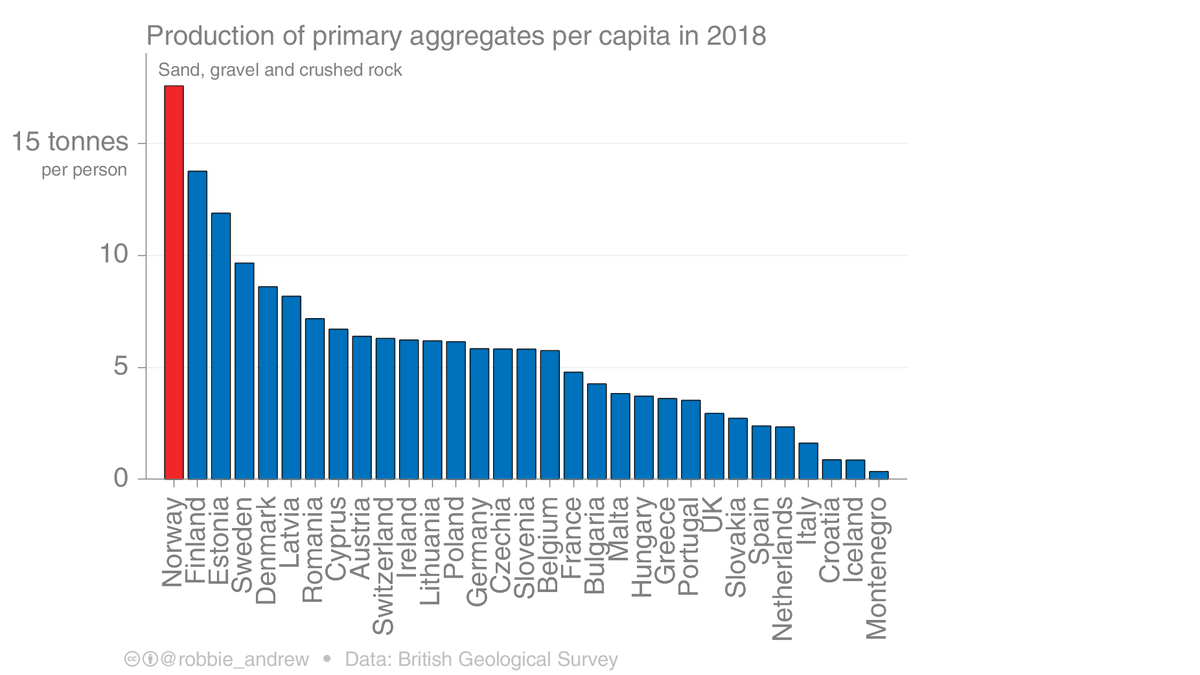With Norway appearing at #16 on the UNDP's experimental PHDI (planetary pressures-adjusted HDI) indicator, a full 15 places lower than its position on the HDI, the question arises: what should or can Norway do about this? Here are some thoughts. https://twitter.com/robbie_andrew/status/1338793322526232577
Firstly, it's important to be clear that Norway still sits at #1 on the UNDP's HDI indicator. This means that Norway is doing a fairly good job of supporting its population's capacity to flourish. Long life expectancy, high education levels, and high average income.
UNDP's new, experimental indicator, the PHDI is a tweak of the HDI. Its purpose is to account for environmental impacts: if high HDI is achieved at the expense of the environment, then countries should be encouraged to look for alternative approaches to human development.
The PHDI adds two sub-indicators: CO₂ emissions and Material Footprint (MF), both measured per capita. Norway sits in 41st place globally for CO₂ emissions per capita, high, but not especially high. Its per capita emissions are very similar to Ireland's.
The second indicator is relatively new, the Material Footprint. The MF attempts to measure the total global physical resource load of each country in tonnes. Trees, rocks, rare earth metals, everything physical that is required worldwide for a country's consumption is summed up.
It should go without saying that this is a difficult accounting exercise. Footprint analysis (material or otherwise) relies on substantial amounts of data and a lot of assumptions. I know this because worked in this field for over ten years.
So the first thing to do is check whether the calculations of Norway's Material Footprint are correct. When teams put together global indicators such as the new PHDI, they simply cannot check every country. UNDP gets the estimates from UNEP, who in term get them from researchers.
The second thing is to look at the goal of the Material Footprint. Its core purpose is to indicate dependence on unsustainable use of the planet's physical resources, but this raises some questions.
In Norway's case, one large component of its Material Footprint is the moving of rock from one place to another. Norway is king of rock, you might say.
So firstly, should the extraction and relocation of rock be considered as detrimental to the environment as the use of trees clear-felled from tropical rainforest?
And secondly, while it might not by definition be sustainable to extract 100 million tonnes of rock every year in Norway for the next thousand years, that is not the plan and unlikely to happen: rocks are extracted for the building of infrastructure. Capital vs operating.
Further, the idea behind MF is that much of the resource extracted from the environment is used and cannot be re-used or recycled. Ecological Economists refer to the 2nd Law of Thermodynamics: high-quality (low-entropy) resources tend to become low-quality (high-entropy) waste.
When we're talking about rock, this quality change is minimal: relocation/distribution (energy is required to recollect it in the same place) and crushing into smaller pieces that cannot be recombined. Quite different to the combustion of tropical timber.
A separate issue is the indirect effects of use of rock: building a road in Norway might require draining wetlands. But the MF isn't here to measure that, and other indicators should be used if we want to include wetland drainage in our index.
Norway's Material Footprint is not about rock, and there are other physical resources in there. Some of these clearly aren't sustainable in any sense, and their use supporting Norway's society might prevent other societies from building their own capacity to flourish.
Importantly, MF is based on consumption: Norway's footprint is everything that through economic flows supports its consumption. This method by definition excludes much of Norway's oil and gas extraction activity, which is largely exported and appears in the MF of other countries.
I think many would agree that this inappropriately absolves Norway. Norway's high position in the HDI rankings is certainly partly a result of income from oil and gas extraction, and the PHDI is supposed to adjust HDI for unsustainable environmental interventions. Here it fails.
In sum, check the data, tease apart different aspects of sustainability (is rock equivalent to tropical timber?), and focus on those that you consider important. Oh, and being at the top isn't the goal. The goal is to help humanity to flourish without damaging the environment.
UNDP's PHDI is an experimental indicator, introduced to try to address the specific question of whether a population's capacity to flourish comes at the expense of the environment. Global indicators are hard to make, and will never, ever measure precisely what you want them to.
But they're not meant to measure precisely. They're indicators, and they indicate something that should be looked at more closely. Just as GDP is an indicator of welfare with many flaws we have to bear in mind whenever we interpret it, so environmental indicators are flawed.
Every indicator must be taken in context of national circumstances, interpreted in the light of understanding of how it is calculated, and the databases underlying it. For all their flaws, we need indicators, because otherwise we have nothing.
UNDP has brought to our attention that humanity's capacity to flourish (as measured by HDI for 30 years) should not be at the expense of nature, and they are to be applauded for this first effort, the PHDI. Work will no doubt continue to improve the index and the underlying data.
That thread was far longer than my normal. You will now be returned to your scheduled programme.

 Read on Twitter
Read on Twitter


